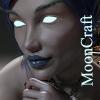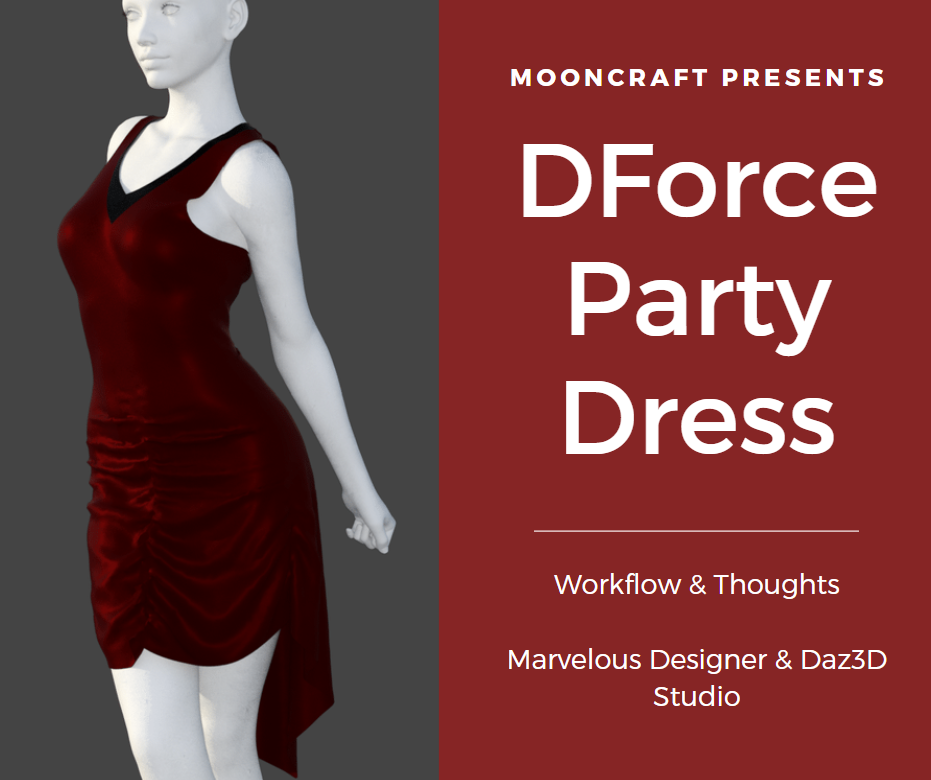Marvelous Designer to Daz 3D Workflow (Tutorial)
 MoonCraft3D
Posts: 379
MoonCraft3D
Posts: 379
I'm learning Marvelous Designer and wanted to document and share my workflow on how to take an outfit from inside Marvelous Designer, and bring it into Daz 3D Studio and save it.
- Part 1 - Simpler Workflow overview, party dress - https://mooncraftrp.com/index.php/2020/06/25/creating-a-dforce-dress-daz3d-studio-marvelous-designer/
- Part 2 - In-depth workflow overview, topcoat - https://mooncraftrp.com/index.php/2020/06/25/dforce-top-coat-workflow-for-marvelous-designer-to-daz-3d-studio/
This is my personal workflow so far, which may change in time. I am always open to new ideas, and tips on how to improve my workflow. That said, if you are using Marvelous Designer and are struggling to get your creations into Daz this may help :)




marvelousdesigner_daz3dstudio_free_dress.png
931 x 780 - 257K


marvelousdesigner_todazstudio_3d_tutorial_mooncraft.png
1163 x 970 - 575K
Post edited by Chohole on


Comments
I'm starting to learn Marvelous Designer as well, so thank you for the posting this!
There's a thread dedicated to this subject in the Technical Help forum:
https://www.daz3d.com/forums/discussion/364011/the-marvelous-designer-thread/p1
I've been using MD since version 6 and with version 9 their simulation is top notch, it can even rival that of Pixar. Aside from being the quintessential program for creating clothes, you can integrate it in an animation pipeline. I created my own Daz Genesis figure and importing it properly in MD as an avatar is currently impossible. Hopefully MD and Daz will have a baby some day.
Marvelous and Designer really need to have a plug-in to have a better flow between.
If DAZ could just buy into the MD simulation technology I'd be happy to buy clothing from the store and drape it using that, which is many times faster than dForce and you can pull and tug it while it is simulating. I tried VWD but that just crashed consistently for me.
Yea, having a tug and pull ability for clothing in dforce would be AMAZING
We do have meshgrabber at least
I have been using MD for a while now and appreciate all tutorials on them. I haven't yet checked these ones out, but I will share a few tips just in case they're not mentioned anywhere else:
1) When exporting from MD, there are two methods: Thin, and thick. THIN is great for testing and applying textures, but thick provides more realistic looking output. Thin (with welding) behaves better with smoothing and collision/dforce options in DAZ. Thick, on the otherhand, does not and seams/corners will "break" and the two-sided meshes won't simulate well. THICK also gives you the option to create surfaces for the sides (edges) and backside of fabrics.
2) When exporting your final product from MD, enable quads for all your polygons and simulate one more time. Triangles do not look good in DAZ when lighting hits from angles, and they do not smooth reliably - especially if you have wrinkles and folds.
3) While topstitching looks very nice in MD, it creates more a lot more vertices when exporting. Whenever possible, use textures to immitate them instead.
4) If you see a lot of poke-through happening in MD with your imported DAZ figure, you should lower the pattern's particle distance (which increases polygon count). This slows down sims, so either do it as part of your final product, or use the newer versions of MD which let you increase polys for regions. Ears, toes, fingernails, and nipples are examples of problem areas.
5) If you need to model something over hair, chances are poke-through will be unavoidable. My solution to this has been "shrink wrapping" a lower poly object around the hair/head using blender, then using that wrapped object for draping in MD.
6) MD does not let you define material surfaces based on internal lines -- which kinda sucks. It does, however, let you arrange the UV map and output a UV stencil.
Hope this helps someone!
MD ver 9 now has GPU simulation which is much faster, almost realtime. Hold down LMB on top of the simulation button and the option will appear. When chosen the arrow should turn from orange to blue.
I didnt know some of these, mind if I repost them into the workflow as helpful info? :)
Thanks for this, more tuts are good.
I just bought a perpetual licence so want to get as much value as possible out of that investment.
Although, I'll export from Studio to MD, then send back to Blender.
Why are you simulating using dForce and not doing it directly in MD?
I don't mind at all! Let me know if I can help with any screenshots of settings or example renders.
Thanks for this treat! I've followed the other mentioned thread, but this thread seem pretty rich with value as well.
cheers,
--ms
I dont understand whats stopping you from importing it into MD "properly"? Cant you just use OBJ, Alembic, MDD options? They all work fine.
One thing that I was thinking about recently, was how useful Daz Studio's transfer utility is to quickly rig clothes to conform to figures. I think that aspect of Daz is quite useful, and would be useful to have in Marvelous Designer. If you want to pose an outfit in MD, currently you need to animate the pose (either as morph target or animation) from the zero pose. In Daz Dforce, you have two options: (1) of doing the simulation from Zero pose or (2) doing simulation from final pose. The latter of which is made possible by rigged clothing, which is a good complement to simulation in terms of streamlining the process, at least for those of us who only do static images and dont need a whole animation.
So i agree that it would be great if MD was useable in Daz so we could take advantage of rigged clothing.
my guess is this is a dforce content creation workflow.
I transfer eventually to Blender as hat is where I render.
I simulate using all three; Blender, Studio and MD. They are tools - so don't get fixated on the tool, but the goal.
I'll export an object as an avatar, and a dforced skirt in the pose, then just tweak in MD; other times I'll do the whole lot in MD; sometimes, I'll just use Blender.
MD's simulation is lightyears ahead of everything else. I don't see the point in using something that only yields inferior results.
MD can't read Daz figure files which is why you can't really import a proper Daz figure for animation in MD. FBX is not an alternative either because MD can't read Dual Quaternion data.
Well the point of making dforce clothing is you can share and sell them to/with Daz community.
what's the problem with exporting from Daz as either Alembic or MDD? I export as alembic from Daz and it seems to be perfectly fine...
Hmm... I never experimented with MDD before, it might even be the thing I'm looking for. Thanks for the suggestion. I tried FBX but the dual quaternion weight maps can't be read by MD among other issues so that's a no go. Now I just use OBJ's and morph targets.
i have never tried MDD myself - supposedly you need the paid version of animate2 in order to export it properly (but not sure about that because the free version also has MDD export option...) All i know is other people use this MDD format successfully.
Side note: MysteryIsThePoint has a free alembic exporter for Daz that seems to work quite well. I have moved to using this one over the Daz one recently. Although sometimes i still use the Daz exporter.
Just tried it. It works great. Export Obj from Daz. Import said Obj as avatar in MD. Then import MDD. It's not really an animation per se but a series of morphs for each individual frame. Now it's all an issue of tweaking the technical aspects as it's not that straight forward of a process on an i7 processor, which is my case.
Great work! This is what we need. Thanks!